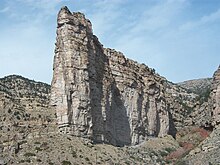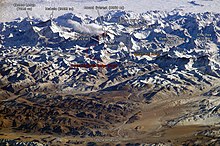- 1
A mountain is a large landform that stretches above the surrounding land in a limited area usually in the form of a peak. A mountain is generally steeper than a hill. The adjective montane is used to describe mountainous areas and things associated with them. The study of mountains is called Orography.
Exogeology deals with planetary mountains, which in that branch of science are usually called montes (singular—mons). The highest mountain on Earth based from sea level is Mount Everest (8,848 m (29,029 ft)) in the Himalayas of Asia. The highest known mountain in the Solar System is Olympus Mons on the planet Mars at 21,171 m (69,459 ft).

The Matterhorn, Swiss Alps
Definition

There is no universally accepted definition of a mountain. Elevation, volume, relief, steepness, spacing and continuity have been used as criteria for defining a mountain.[1] In the Oxford English Dictionary a mountain is defined as "a natural elevation of the earth surface rising more or less abruptly from the surrounding level and attaining an altitude which, relatively to the adjacent elevation, is impressive or notable."[1]
Whether a landform is called a mountain may depend on usage among the local people. The highest point in San Francisco, California, is called Mount Davidson, notwithstanding its height of 300 m (980 ft), which makes it ten feet short of the minimum for a mountain by American designations.[citation needed] Similarly, Mount Scott outside Lawton, Oklahoma is only 251 m (823 ft) from its base to its highest point.
Definitions of "mountain" include:[2]
- Height over base of at least 2,500 m (8,202 ft).
- Height over base of 1,500 m (4,921 ft).–2,500 m (8,202 ft). with a slope greater than 2 degrees
- Height over base of 1,000 m (3,281 ft).–1,500 m (4,921 ft). with a slope greater than 5 degrees
- Local (radius 7,000 m (22,966 ft). elevation greater than 300 m (984 ft)., or 300 m (984 ft)–1,000 m (3,281 ft). if local (radius 7,000 m (22,966 ft). elevation is greater than 300 m (984 ft).
By this definition,[which?] mountains cover 64% of Asia, 25% of Europe, 22% of South America, 17% of Australia, and 3% of Africa. As a whole, 24% of the Earth's land mass is mountainous and 10% of people live in mountainous regions.[3] Most of the world's rivers are fed from mountain sources, and more than half of humanity depends on mountains for water.[4][5]
[edit] Characteristics
Tall mountains reach into the colder layers of the atmosphere. They are consequently subject to glaciation, and erosion through frost action. Such processes produce the peak shape. Some of these mountains have glacial lakes, created by melting glaciers; for example, there are an estimated 3,000 glacial lakes in Bhutan. Mountains can be eroded and weathered, altering their characteristics over time.
Tall mountains have different climatic conditions at the top than at the base, and will thus have altitudinal zonation of ecosystems. At the highest elevations, trees cannot grow, and whatever life may be present will be of the alpine type, resembling tundra.[6] Just below the tree line, one may find subalpine forests of needleleaf trees, which can withstand cold, dry conditions.[7] In regions with dry climates, the tendency of mountains to have higher precipitation as well as lower temperatures also provides for varying conditions, which in turn lead to differing flora and fauna.[6][8] Some plants and animals found in these zones tend to become isolated since the conditions above and below a particular zone will be inhospitable and thus constrain their movements or dispersal. On the other hand, birds, being capable of flight, may take advantage of montane habitats and migrate into a region that would otherwise not provide appropriate habitat.[9] These isolated ecological systems, or microclimates, are known as sky islands.[10]
The reason mountains are colder than lowlands has to do with how the sun heats the surface of the Earth. Practically all the heat at the surface of the Earth comes from the sun, in the form of solar energy. The sun's radiation is absorbed by land and sea, whence the heat is transferred into the air. Air is an insulator, so conduction of heat from the ground to the atmosphere is negligible. Heat is mainly transferred into the atmosphere through convection and radiation. Warm air rises because of its buoyancy, leading to convective circulation, in the form of thermals, within the lowest layer of the atmosphere, the troposphere. When heat radiates from the surface of the earth, it is released as long-wave radiation, which does not travel through the air efficiently. This radiant heat is absorbed temporarily by gasses in the atmosphere, such as carbon dioxide and water vapor. Thus, the lower portion of the troposphere—more than 50% of all air lies below the altitude of the summit of Mt. Everest—forms a blanket of air keeping the surface warm. This is the Greenhouse Effect. The higher one goes in altitude, the less of this blanket there is to keep in the heat. Thus, higher elevations, such as mountains, are colder than surrounding lowlands.[11] Air temperature in the lowest layer of the atmosphere, the troposphere, decreases with gains in altitude. The rate at which the temperature drops with elevation, called the environmental lapse rate, is not constant (it can fluctuate throughout the day or seasonally and also regionally), but a normal lapse rate is 5.5°C per 1,000 m (3°F per 3,000 ft).[12][13] The temperature continues to drop up to a height of about 9–16 km, where it does not decrease further. However, this is higher than the highest mountaintop.
Mountains are generally less preferable for human habitation than lowlands; the weather is often harsher, and there is little level ground suitable for agriculture. At very high altitudes, there is less oxygen in the air and less protection against solar radiation (UV). Acute mountain sickness (caused by hypoxia—a lack of oxygen in the blood) affects over half of lowlanders who spend more than a few hours above 3,500 metres (11,480 ft).
Many mountains and mountain ranges throughout the world have been left in their natural state, and are today primarily used for recreation, while others are used for logging, mining, grazing, or see little use. Some mountains offer spectacular views from their summits, while others are densely wooded. Summit accessibility is affected by height, steepness, latitude, terrain, weather. Roads, lifts, or tramways affect accessibility. Hiking, backpacking, mountaineering, rock climbing, ice climbing, downhill skiing, and snowboarding are recreational activities enjoyed on mountains. Mountains that support heavy recreational use (especially downhill skiing) are often the locations of mountain resorts.
Mountains are made up of earth and rock materials. The outermost layer of the Earth or the Earth's crust is composed of seven primary plates. When two plates move or collide each other, vast land areas are uplifted, resulting in the formation of mountains.
- Fold mountains
- Fold mountains are the most common type of mountains. They are formed due to collision of two plates, causing folding of the Earth's crust. The fold that descends on both sides is called anticline; whereas, the fold that ascends from a common low point (on both sides) is called syncline. Examples of fold mountains are the Himalayas of Asia and the Alps in Europe.
- Fault-Block mountains
- As the name suggests, fault-block mountains or fault mountains are formed when blocks of rock materials slide along faults in the Earth's crust. There are two types of block mountains, namely the lifted and tilted. Lifted mountains have two steep sides; whereas, the tilted type has one steep side and a gentle sloping side. Examples of fault-block mountains are found in the Sierra Nevada mountain range of the western United States.
- Volcanic mountains
- Volcanic mountains are formed due to volcanic eruptions where magma piles up on the surface of the Earth. Examples of volcanoes include Mount Fuji in Japan and Mount Pinatubo in the Philippines.
- Dome mountains
- Dome mountains are formed when the hot magma rises from the mantle and uplifts the overlying sedimentary layer of the Earth's crust. In the process, the magma is not erupted, but it cools down and forms the core of the mountain. They are called dome mountains due to their appearance that resembles a dome shape. An example of a dome mountain is Navajo Mountain in the U.S. state of Utah.

- Plateau mountains
- Plateau mountains are pseudo mountains that are formed because of erosion. They usually occur near folded mountain ranges. An example of a plateau mountain is the Adirondack Mountains in the U.S. state of New York.
Some mountains are formed as a result of several of the Earth's forces. Though the Rockies in North America is formed due to folding, there are mountains in the same range that are formed by faulting and doming. In nature, there is a continuous process of glaciation, soil erosion, and mechanical and chemical weathering, which altogether play a major role in altering the shape and characteristics of mountains.
[edit] Geology
A mountain is usually produced by the movement of lithospheric plates, either orogenic movement or epeirogenic movement. Compressional forces, isostatic uplift and intrusion of igneous matter forces surface rock upward, creating a landform higher than the surrounding features. The height of the feature makes it either a hill or, if higher and steeper, a mountain. The absolute heights of features termed mountains and hills vary greatly according to an area's terrain. The major mountains tend to occur in long linear arcs, indicating tectonic plate boundaries and activity. Two types of mountain are formed in this way depending on how the rock reacts to the tectonic forces, — fold mountains or fault-block mountains. Other mountain building processes include volcanoes and sea floor spreading.
[edit] Fold mountains
Compressional forces in continental collisions may cause the compressed region to thicken and fold, with material forced both upwards and downwards. Since the less dense continental crust "floats" (cf iceberg) on the denser mantle rocks beneath, the weight of any crustal material forced upward to form hills, plateaus or mountains must be balanced by the buoyancy force (see isostasy) of a much greater volume forced downward into the mantle. Thus the continental crust is normally much thicker under mountains ( sometimes called "mountain roots"),[14] compared to lower lying areas. However, in many continental collisions (e.g. the Himalayas) part of one continent may simply override the other, crumpling in the process with the overridden crust forming much of the support. Mountains may similarly be partly supported by oceanic crust subducted beneath the continental crust (e.g. the Andes as the Nazca plate flows beneath the South American Plate).
[edit] Fault-block mountain
Block mountains are created when large areas are widely broken up by faults creating large vertical displacements. This occurrence is fairly common. The uplifted blocks are block mountains or horsts. The intervening dropped blocks are termed graben: these can be small or form extensive rift valley systems. This form of landscape can be seen in East Africa, the Vosges, the Basin and Range province of Western North America and the Rhine valley. These areas often occur when the regional stress is extensional and the crust is thinned.
Rock that does not fault may fold, either symmetrically or asymmetrically. The upfolds are anticlines and the downfolds are synclines: in asymmetric folding there may also be recumbent and overturned folds. The Jura Mountains are an example of folding. Over time, erosion can bring about an inversion of relief: the soft upthrust rock is worn away so the anticlines are actually lower than the tougher, more compressed rock of the synclines.
[edit] Volcanoes
Some isolated mountains are produced by volcanoes, including many apparently small islands or seamounts that reach a great height above the ocean floor.
[edit] Mid-ocean ridges
The mid-ocean ridges formed during sea-floor spreading are often referred to as undersea mountain ranges due to their bathymetric prominence.
- 1







